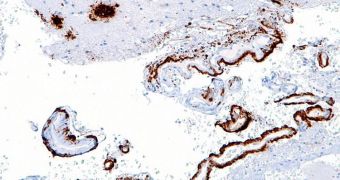Research scientists based at the Institute for Research in Biomedicine in Barcelona, Spain, say that they recently identified a series of molecules that may be responsible for the development of Alzheimer's.
The group revealed that structures called amyloid fibrils (or plaques) – which have been proposed as the main culprit causing the condition - are not in fact responsible for the onset of symptoms related to Alzheimer's disease.
Experts say that they managed to identify a series of molecules that were observed to be passing in and out of the amyloid plaques. They say that these small structures are in fact the ones responsible.
At the same time, they may represent the key to treating Alzheimer's disease, the IRB group explained. Experts could now investigate these molecules in great detail, and then figure out ways of targeting them with a new series of drugs.
Another important finding in the research was that the amyloid fibrils are not static, as previously believed. The motion they are exhibiting is called molecular recycling, and is enabled by small traveling molecules called oligomeres.
These compounds literally travel in and out of brain proteins, and the IAB team determined that they are the reason why Alzheimer's symptoms set in. The work was led by expert Natàlia Carulla.
Her team focused on plaques produced by the Amyloid Beta 40 (AB 40) and Amyloid Beta 42 (AB 42) proteins. The main discovery was that molecules from these fibrils seemed to become loose from the structures, get circulated about, and then get reintegrated.
This molecular recycling mechanism may be to blame for the onset of the neurodegenerative disease. “These amyloid fibrils found in the brain were thought to be the culprits of the disease,” Carulla says.
The expert admits that more work is needed before the discovery is validated, but adds that preliminary verifications have demonstrated the new proposals to be true.
“Understanding the molecular basis of the disease requires knowledge about the interconversion between the different species present during AB protein aggregation,” the team leader goes on to say.
“We are happy to have contributed to demonstrate that AB fibrils are not static – they are dynamic. Even when the molecules are incorporated into the fibrils, they are able to go out of the fibrils and come back in,” she explains.
“Our research aims to contribute to a detailed molecular understanding of AB aggregation so that it can be used to develop therapeutic strategies through which Alzheimer’s disease can be prevented or cured,” Carulla concludes, quoted by MEDILL.

 14 DAY TRIAL //
14 DAY TRIAL //